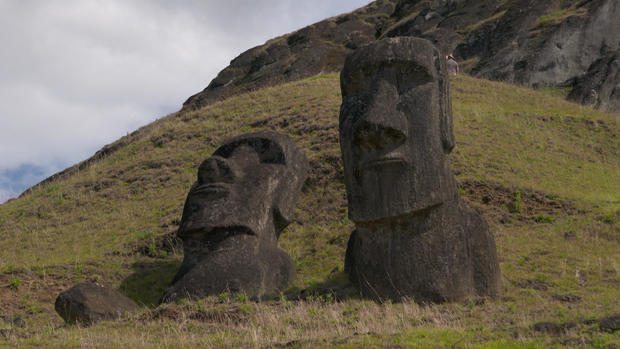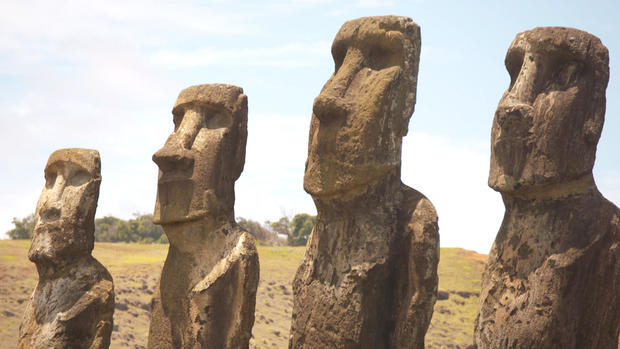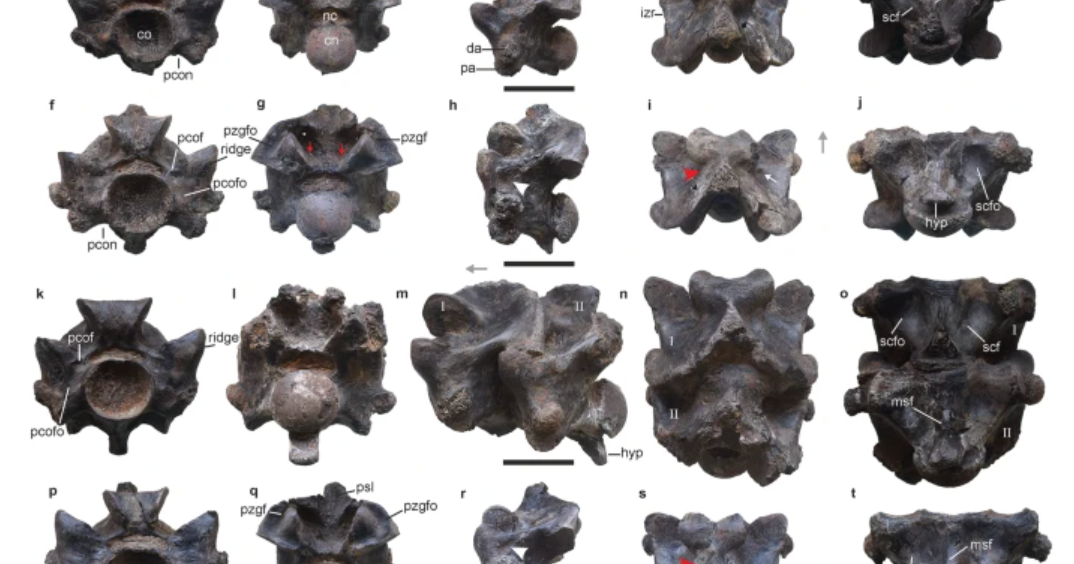Easter Island's famous moai statues slowly fading away
On this Easter Sunday, we thought it would be fitting to take you on a journey to Easter Island. It's one of the most remote inhabited islands in the world, far into the pacific, 2200 miles due west from the coast of Chile.
Dutch explorers gave it its name after they spotted it on Easter Sunday in 1722. What they found has fascinated and confounded the world ever since, giant stone statues that tower over the island's landscape. They're called moai, and as we learned our first morning on Easter Island, there is nothing quite like them anywhere else in the world.
When dawn breaks on Easter Island, it is the moai that first feel the sun.
These 15 moai at a site called Tongariki are perhaps the most famous. Carved out of volcanic rock, they're placed on a stone platform called an ahu. The tallest is nearly 30 feet. They stand, strange silent sentinels, facing away from the sea, watching over the land and its people.
At least a thousand moai can be found scattered across this island, which is about the size of Washington DC. Many more moai remain buried underground. To the descendants of those who built them, these are more than statues made of stone, they are immortal branches of an ancient family tree.
Pedro Edmunds Paoa: The moai represent an ancestor. And we believe in ancestor that goes beyond this life but is helping us, guiding you.
Anderson Cooper: Is a moai a distinct individual ancestor? Or can it also be the family line of that ancestor?
Pedro Edmunds Paoa: Both.
Pedro Edmunds Paoa is the longtime mayor of the only town on Easter Island.
Anderson Cooper: So when you see the moai today, it's not just something from the past. It's something that is alive that has power right now?
Pedro Edmunds Paoa: Yes. We indigenous people from this island believe in that.
The indigenous people here believe their ancestors and family lines are represented by specific groups of moai. Mayor Edmunds Paoa says his are at a site called Tahai.
Pedro Edmunds Paoa: My genealogy traces to all the way to that site 85 times.
Anderson Cooper: It goes back that far?
Pedro Edmunds Paoa: Yes. More than a thousand years.
That is entirely possible. No one knows for sure the exact date the first people came here, but it's believed to have been somewhere around 800 to 1200 years ago. Archaeological evidence indicates they sailed, from an unknown island in Polynesia, a dangerous journey across more than 1,000 miles of open ocean.
Those first settlers brought with them their tradition of carving, but they made much smaller statues. They also brought a belief in a mystical force called mana.
Anderson Cooper: How do you describe mana? What is mana?
Pedro Edmunds Paoa: Mana is- is- is- is beyond description. If we were to describe it of today's language, is knowledge.
Anderson Cooper: Knowledge?
Pedro Edmunds Paoa: Could be interpreted as wisdom as-- an energy that gives you strength.
Anderson Cooper: Do the Moai still have mana?
Pedro Edmunds Paoa: Sure. It has soul. It has life.
Anderson Cooper: They're alive?
Pedro Edmunds Paoa: Absolutely.
According to legend, when important islanders died, their mana flowed out of their bodies into the moai.
Pedro Edmunds Paoa: The mana is here. The mana is here.
Anderson Cooper: It's a hard concept for my small mind to imagine.
Pedro Edmunds Paoa: for human like you guys from the city, you don't understand these things 'cause you worry about working, like, disciplined animals.
Those who believe in mana say it's not just in the moai, it can be found in everything here -- in the waves that constantly crash ashore, in the rocky soil and in the green grass that blankets the island.
Jo Anne Van Tilburg: These objects in the middle of what looks like a barren landscape. They speak to you. They draw you in. They-- they make you want to-- to know more. I think that that's the power of them.
Jo Anne Van Tilburg is a UCLA professor of archaeology. She has been coming here for nearly 40 years, working with local researchers and artists, excavating and cataloging the statues, trying to understand the mysteries, and what she calls, the magic of the moai.
Jo Anne Van Tilburg: They're tight-lipped, these statues.
Anderson Cooper: They don't give up their secrets easily--
Jo Anne Van Tilburg: They-- they don't give up their secrets easily. And they don't give 'em up to outsiders easily.
To learn the moai's secrets, you have to start where nearly all of them were made. Around the vent of a dormant volcano, this is the ancient quarry of Rano Raraku. There are some 400 moai here, more than in any other spot on the island. The largest one, never raised upright, is almost 70 feet long and weighs at least 250 tons, as heavy as some passenger jets.
Based on excavations Jo Anne Van Tilburg and other archaeologists have done, and analysis of soil samples and objects found around the statues, Van Tilburg believes the height of moai construction was around 1300 to the mid 1400s. Though moai did continue to be carved until or just after the first contact with Europeans in 1722.
Anderson Cooper: I mean, is it not possible with carbon dating or other scientific techniques to know exactly when--
Jo Anne Van Tilburg: Unfortunately not. You can't date stone, this stone in that manner.
When the first archaeological survey was done on the island in 1914, all the moai except those in the quarry were found lying on the ground.
There are several plausible theories how they got there. Certain statues may have simply fallen from neglect, others were knocked over in earthquakes and some were intentionally toppled during fighting between competing family groups.
Today some moai are only partially visible, just their famous faces stick out of the ground, the rest of their bodies are buried under sediment that's naturally built up over the centuries.
Jo Anne Van Tilburg: This one is at least-- only about one third above ground.
Anderson Cooper: Wow. So two thirds of this are actually below ground.
Jo Anne Van Tilburg: Yes, yes.
At first glance the moai all look alike, but Van Tilburg says no two are the same.
Anderson Cooper: How are they different?
Jo Anne Van Tilburg: Well they're different in the line of their mouth. They're different in, of course, their size and shape. They're different in their expressions. Whether their head is tilted up, or lowered slightly, or to the side.
Anderson Cooper: These two moai -- they're unfinished?
Jo Anne Van Tilburg: They're unfinished.
Visitors here have long debated how the moai were made, given the stone age conditions on the island, when the statues were being carved. Van Tilburg says, the answer is all around. There are thousands of stone-carving tools scattered throughout the quarry.
Jo Anne Van Tilburg: This was a handheld instrument that was used. And if you hold it you can-- actually feel where people may have put their fingers.
Anderson Cooper: Wow.
Jo Anne Van Tilburg: Which was actually used to rough out the sculpture.
Anderson Cooper: You can actually feel the-- sort of the-- the hand--
Jo Anne Van Tilburg: Yeah, you can.
Anderson Cooper: Wow. That's amazing.
Jo Anne Van Tilburg: Isn't that cool?
Anderson Cooper: I mean -- and this was literally just laying ten feet away. I mean--
Jo Anne Van Tilburg: And you put it in your hand, and you can feel where the other person's hand was who-- who ac-- who actually-- used this.
Anderson Cooper: That's incredible.
Jo Anne Van Tilburg: When you talk about mystery and magic, that's it, right there.
But magic alone couldn't move the moai from the quarry to sites on the coast, in some cases, more than eight miles away. That took muscle and ingenuity. Van Tilburg has tested a theory she believes. That moai were placed horizontally on sleds, and dragged over logs.
Island legend says the statues walked, and some archaeologists have tested that theory as well, moving them upright, carefully wobbling them back and forth.
You may have also heard an out of this world theory about space aliens making and moving the moai. It may sound ridiculous but it's still believed by many visitors today.
Anderson Cooper: You must have people asking you about extraterrestrials--
Jo Anne Van Tilburg: Yes.
Anderson Cooper: --building these.
Jo Anne Van Tilburg: Yes, I do.
Anderson Cooper: So, I mean, I just have to ask, any possibility of that? You don't believe it though.
Jo Anne Van Tilburg: No, I don't believe it.
Easter Island was annexed by Chile in 1888. Half of the 8,000 people who now live here are Chilean immigrants. The other half are modern descendants of those original Polynesian settlers. They call themselves, and the island, Rapa Nui. In 2017, Chile finally gave them control of the national park where the moai and other important archaeological sites are located. The park covers more than 40 percent of the island.
The island of Rapa Nui was formed out of volcanic rock starting some 3 million years ago. There are now 3 dormant volcanoes that dominate the landscape. This one is called 'Rano Kau.' No one knows exactly how many archaeological sites there are on the island but this place is like a living museum, constantly battered by the sun, the wind and the rain.
Those three elements are, over time, destroying the moai.
These statues may look as though they're solid stone, but they're actually quite porous. Jo Anne Van Tilburg showed us a small piece of the soft volcanic rock called tuff that the moai are made from.
Jo Anne Van Tilburg: Tuff has really special qualities that-- where it can be carved and it can be polished quite easily.
Anderson Cooper: It's good for sculpting because it-- it's-- with a harder stone, it's able to be chipped away easily.
Jo Anne Van Tilburg: Correct. Correct.
Anderson Cooper: So the very material which made-- made these statues possible-- also, long term, makes them vul-- very vulnerable.
Jo Anne Van Tilburg: Exactly.
Rainwater and airborne seeds get into the pores of tuff, gradually breaking it apart. The wind whittles the stone away over time, and further damage is done by birds, and a type of algae called lichen.
Some moai are in worse condition than others. Take a look at this one called Tukuturi. This photograph is from 1955, when it was unearthed. This is how Tukuturi looks today.
Jo Anne Van Tilburg: The stone breaks very easily. It is just not stable.
Anderson Cooper: Essentially, I mean, they're dissolving.
Jo Anne Van Tilburg: Yeah, they are. I mean, if they're standing out in the rain, they're melting like sugar cubes.
Anderson Cooper: Like sugar cubes in the rain?
Jo Anne Van Tilburg: Exactly. It's that dramatic.
In the 1990s, with help from the Japanese government, the 15 moai at Tongariki, which had fallen or been toppled over, were reconstructed along with the stone platform they now stand on.
The UN has declared Easter Island a World Heritage Site, and efforts to slow the disintegration of the statues with a chemical sealant have been underway for decades, but so far only about 20 moai have been treated.
The process is expensive, money the island doesn't have. It's also not a permanent solution. The sealant only delays the inevitable. One day these moai will likely disappear.
Anderson Cooper: Is there a plan? A-- conservation plan? An environmental plan for long term, in the future?
Pedro Edmunds Paoa: No.
Anderson Cooper: There's not?
Pedro Edmunds Paoa: None. None at all.
Mayor Pedro Edmunds Paoa is frustrated. There is a lack of consensus among the Rapa Nui about how to preserve the moai. And the island's infrastructure is under pressure from all the tourists who want to come see the statues.
A few decades ago there were only two incoming flights a week.
Now there are two almost everyday.
Cruise ships also make regular calls, just long enough for passengers to get off the boat, grab some souvenirs and snap a few selfies. In all, 120,000 tourists visited last year.
Pedro Edmunds Paoa: That's too much.
Anderson Cooper: If tourism continues to grow, is that sustainable here?
Pedro Edmunds Paoa: No-- it's not sustainable.
Cristian Moreno Pakarati is a historian who earns his living training tour guides.
Anderson Cooper: Do you have concerns about the impact of tourism?
Cristian Moreno Pakarati: So in material terms-- the community has never been better. But in general it's much less friendly than it was some time ago.
He says the more the island caters to tourists, the less like home it is for the people whose ancestors built the moai.
Cristian Moreno Pakarati: Today we are kinda forced to see the statues from far away, just like the tourists that come here. People of my generation, right, we could go there and touch the statues, and-- and be part of the statues, and hug the statues. How can I explain to my son today that my son cannot do that?
Despite no longer being able to touch them, he still feels the same sense of wonder he's always experienced when visiting the moai.
Anderson Cooper: You've been here probably thousands of times.
Cristian Moreno Pakarati: A thousand times. Yeah. No, it's still awesome. It's something that you-- you still feel awe when you're here.
Cristian Moreno Pakarati supports the efforts to preserve the moai, but believes it will take more than mana and money. He has his own, somewhat radical idea on how to ensure the moai keep standing.
Cristian Moreno Pakarati: The only way to keep them alive is to keep alive the art of making and moving statues.
Anderson Cooper: So you would like to see the people of Rapa Nui making new moai.
Cristian Moreno Pakarati: That's right. Because these will disappear one day. So if the art of making them is still alive, we will never lose the statues.
Produced by Keith Sharman. Associate producer, Alex J. Diamond.








